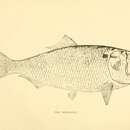mk
имиња во трошки


Perception Channels: tactile ; chemical
Menhaden are not threatened in or around the United States. They do not appear in the IUCN red list, which means that their species is safe from extinction as of now. Examples of regulations and status of menhaden can be found at NOAA (1999).
US Federal List: no special status
CITES: no special status
Menhadens by themselves are considered a harmless species. However, when large numbers of these fish come in contact with the dinoflagellate Pfiesteria piscicida, many health risks become readily exposed to humans. Pfiesteria changes into a toxic encysted stage when it inhibits the menhadens. This causes health risks ranging from epidermal problems to central nervous system problems.
Menhadens are considered highly commercial fish for the United States. They are used in the production of such things as: oil, fertilizer and fishmeal. They can also be found marketed for consumption, either fresh, smoked, salted, or canned. This species was realized recently to have a very significant value as an alternative for whale oil. They are also used for lubricants and as fuel for lamps. Since these fish have begun to be used as an alternative oil, they are being used for making soaps and paints. Virginia, North Carolina and the Gulf are major ports for the menhaden. There are more menhaden brought onto US land each year than any other fish. Their input ranges from 300,000 to 400,000 metric tons per year.
Menhadens feed by filtering. They consume from the primary trophic levels, including phytoplankton and zooplankton. Their main food source also includes detritus(dead organic matter found in the water, usually settled on the bottom), plants/detritus and animals. Menhadens' food consumption is usually 31.40 times their body weight per year.
Brevoortia tyrannus, commonly called the Atlantic Menhaden, can be found anywhere in the western Atlantic, Nova Scotia, Canada and southward to Indian River, Florida, USA. Menhaden are also common in all salinities of the Chesapeake Bay.
Biogeographic Regions: atlantic ocean (Native )
For the most part menhadens can be found at a depth of up to -20m. This puts them in the palagic, brakish, marine area of the Atlantic Ocean. In this habitat predators of the menhadens consist of such aquatic animals as sharks, rays, and bony fish. Also, parasites like isopods, copepods, cestodes, and trematodes are found on the menhadens.
Aquatic Biomes: coastal
Brevoortia tyrannus can be described as a silvery in color. However, the sides of it differ from the silver color and range closer to a brassy color. Menhadens have dark bluish green backs. They are usually characterized by a small, irregularly placed scales on their backs, above their anal fins. They are also characterized by a black spot that is usually behind their gill openings. Following this larger black spot are approximately six lines of smaller spots. They have inner and outer finrays and a pelvic fin with rounded hind margins.
Average mass: 1283 g.
Other Physical Features: bilateral symmetry
Spawning for menhadens occurs all year long. However, productive spawning has been noted to occur from March to May and again between September and October. Estuaries are usually the safest salt water havens within menhadens habitat so their nurseries occur there. Breeding can be limited by high water temperatures.